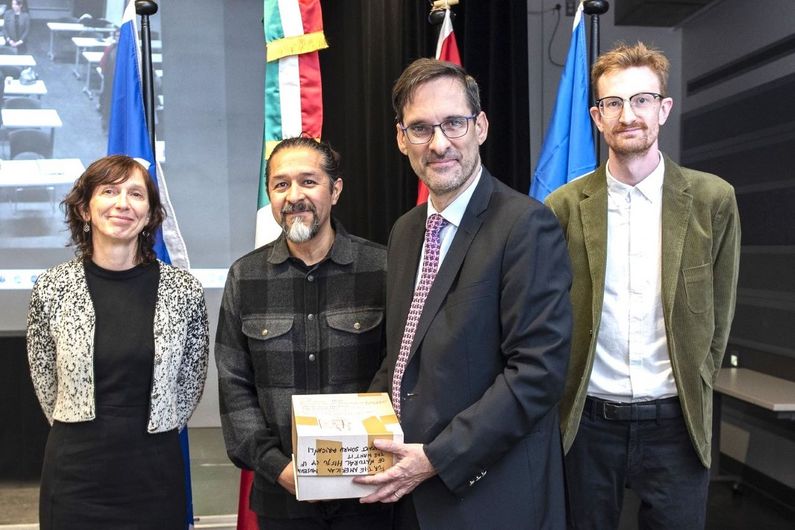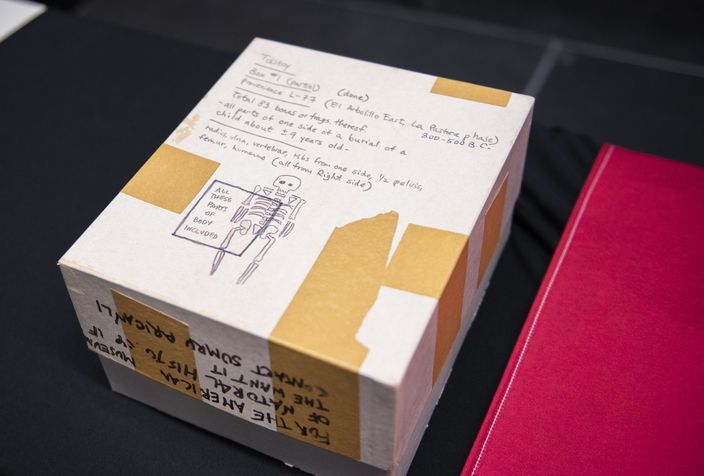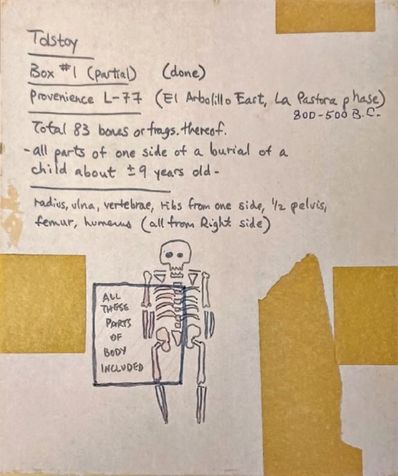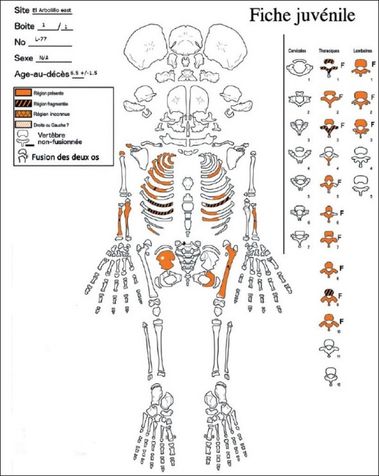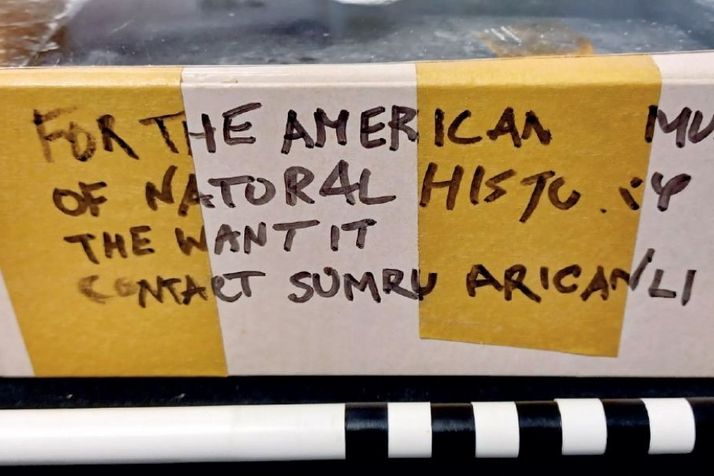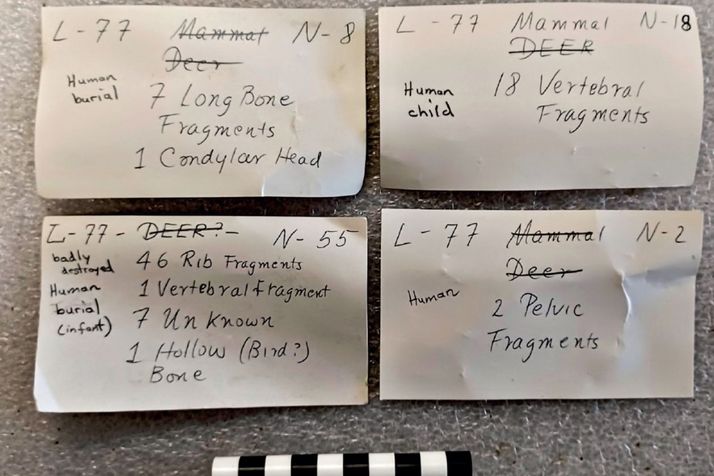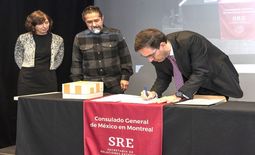The long journey of a child who died over 2,000 years ago
- UdeMNouvelles
02/07/2024
- Julie Gazaille
UdeM’s Department of Anthropology hosted a delegation from the Consulate General of Mexico in Montreal for a ceremony marking the return of Mesoamerican human remains.
In 2020, the pandemic disrupted everyone's lives, isolated people from each other and ushering in a new reality for all. At universities, activities shifted into low gear and moved online. And in Université de Montréal’s Department of Anthropology, then-director Guy Lanoue took the opportunity to do something he’d never had time for: tidy up.
He was in for quite a surprise. On a dusty shelf, Lanoue found a shoebox-sized cardboard container – and inside were the bones of a child, born in antiquity. At least, that’s what was written on the top of the box. Where did the bones come from and what were they doing there? An investigation was in order.
Lanoue called in his colleague Isabelle Ribot, a bioarchaeologist specializing in ancient human remains. After a brief examination, she concluded that the bones were indeed many centuries old. She, too, had no idea how they'd ended up on a shelf in the Department of Anthropology.
Three years later, in early December 2023, with the pandemic over and campus life back to normal, the bones – now dubbed "El Niño" – found a new home. In a private ceremony captured for posterity by UdeM's staff photographer, Ribot handed the box over to Mexico's consul-general in Montreal, Alejandro Estivill Castro.
Alongside his vice-consul and other officials, the diplomat thanked Ribot for returning the bones. The ceremony marked the first time ever at UdeM that ancient remains had been turned over to their rightful owners.
Some notes, one drawing and an inscription
A long series of events had led to that day.
In 2020, with nothing to go on besides a few scribbled notes left in the box, Ribot decided to entrust the investigation of the bones to one of her best students, Étienne Houle, who was completing a master’s degree in anthropology. She asked Carlos Jacome, a visiting professor from Mexico and expert in forensic archaeology and Mesoamerican bioarchaeology, to co-supervise the student.
Houle had a few clues to El Niño’s story: notes on the box described the origin of the remains and dated them as possibly from the La Pastora subphase (750-550 BCE) of a period known as the Zacatenco, named after the main village in a region of Mexico where Indigenous populations practiced agriculture.
A rough drawing on the top of the box indicated that it contained only one individual in a very incomplete state: 75 bone fragments from a six-and-a-half-year-old child who lived more than 2,000 years ago.
On one side of the box was an additional inscription that helped Houle make progress: "For the American Museum of Natural History if they want it. Contact Sumru Aricanli."
Brought back from a dig in '65
Aricanli is an expert in South American, Mexican and Central American archaeology at the American Museum of Natural History (AMNH), in New York City. Houle contacted her and learned that, back in 1965, Paul Tolstoy, founder of UdeM’s anthropology department, had brought the bones back from a dig he'd done in Mexico. After retiring in 2014, he left no forwarding address but stayed in touch with Aricanli.
Aricanli explained that Tolstoy transferred his entire collection, composed mainly of ceramic and lithic artefacts, to the AMNH in 2014 but it included no human remains. Tolstoy specialized in the cultural diffusion of Mesoamerican societies; he never mentioned the El Niño bones in any publications on his research. In fact, when they were discovered, it appeared the bones had originally been mislabeled as those of a deer: the inscription “deer” on the box had been crossed out and replaced by “human child.”
Kent V. Flannery of the University of Michigan—a sheet of paper left in the box bore the school’s crest—also helped solve the mystery. At Tolstoy’s request, he had worked on analyzing some of the artifacts brought back from the 1965 dig and had apparently reported the presence of juvenile human bones among the faunal remains before they were brought to Montreal.
Houle and his colleagues hypothesize that Tolstoy most likely brought the bones back by mistake, unaware they were of human origin.
The remains were unearthed by the team of UdeM archaeologists in 1965 at the El Arbolillo site near Tlalnepantla de Baz, in south-central Mexico, though the exact location remains uncertain. Tolstoy died in fall 2022 but he had an email exchange with Houle in the spring and provided some valuable information.
“He distinctly remembered these remains,” said Houle. “Thanks to the information he gave us, we were able to set this repatriation in motion, since we support the return of bioarchaeological collections and their centralization in their country of origin.
Repatriation procedures and a scientific article
Meanwhile, Jacome handled the lengthy repatriation procedures with Mexican authorities and scientists from the Instituto Nacional de Antropología e Historia, in Mexico City. The three UdeM researchers wrote a scientific article about the singular discovery, the subsequent investigation and the repatriation process, and it was published in the fall 2023 issue of the Quebec journal Archéologiques.
The article is divided into three parts: the osteological inventory, the archaeological context of the discovery, and the ethical and international legal considerations associated with the repatriation of these human remains.
“The ethics of the conservation of archaeological human remains has become a major concern in the 21st century for communities and for researchers,” the three anthropologists wrote in the introduction to the article. “The novel process of El Niño’s international repatriation brings up ethical and legal issues that have also been raised by many other requests for repatriation in recent years.”
“This case study highlights the need to take ethical considerations into account in the management of bioarchaeological collections and to clarify processes for the return of human remains to ensure respect for the deceased and their home communities,” said Ribot. She also noted the need to balance conflicting claims for the scientific preservation of human remains in educational institutions and the cultural and spiritual dignity of the Indigenous communities concerned.
Human dignity must prevail over the materialistic approach of the scientific community, the three researchers argue: “While the Western worldview is sometimes emotionally detached from ancient artifacts, many Indigenous communities feel an emotional connection to their ancestors,” said Houle. “They believe that the dead are entitled to dignity regardless of the passage of time, just like someone who dies today.”
Who do human remains belong to?
The article also discusses issues involving the cultural affiliation of human remains. Should remains be returned only to groups with demonstrated geographic, genetic and cultural affiliations? Challenges arise when remains cannot be culturally identified according to scientific standards, and this hampers communities in their efforts to get them repatriated. This was the case with El Niño.
The process of returning the bones revealed gaps in Canadian and Mexican laws on the repatriation of human remains and drew attention to the codes of ethics and professional conduct that guide practices in bioarchaeology. Institutions will have to work to clarify procedures for this type of repatriation in future, the anthropologists say.
As the Mexican consul noted more than once in December during the handover of El Niño's remains, the adventure of this child who died over 2,000 years ago is not over yet. Mexican scientists plan to study the remains as part of ongoing work in Mexico on the Teotihuacán period. And so, after decades on a shelf, El Niño will help researchers enrich what we know about the people who inhabited the Americas before us.


